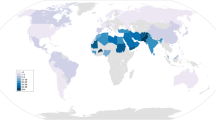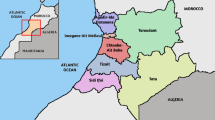Abstract
The population of India is composed of many thousands of subpopulations, divided by geography, language, religion and caste or biraderi (patrilineage) boundaries, with endogamous marriage the norm. The net effect has been the creation of multiple genetic isolates with individual mutation profiles, but to date the clinical consequences of this highly complex differentiation have been largely ignored. In contrast, the topic of consanguinity continues to attract attention among medical and population geneticists, clinicians and social scientists. The significant progress made in India in improving childhood nutritional status and combating infectious disease means that genetic disorders have assumed everincreasing importance. In populations where consanguineous marriage is widely practised, recessive genetic disorders will continue to gain greater prominence in the overall spectrum of ill health. At the same time this increase will in part be negated by urbanization and the move to smaller family sizes, which predictably will result in a decline in the prevalence of consanguineous unions. Developing an understanding of these changes will require a wide-ranging and multidisciplinary investigative approach for which community genetics is ideally suited.
Similar content being viewed by others
References
Agarwal S. S., Singh U., Singh P. S., Singh S. S., Das V., Sharma A., Mehra P., Chandravati, Malik G. K. and Misra P. K. 1991 Prevalence and spectrum of congenital malformations in a prospective study at a teaching hospital.Indian J. Med. Res. B94, 413–419.
Ahmed S., Saleem M., Modell B. and Petrou M. 2002 Screening extended families for genetic hemoglobin disorders in Pakistan.New Engl. J. Med. 347, 1162–1168.
Appaji Rao N., Savithri H. S., Radha Rama Devi A. and Bittles A. H. 1998 Consanguinity—a common human heritage? The effects on the health and well-being of Indian populations. InThe Indian human heritage (ed. D. Balasubramanian and N. Appaji Rao), pp. 11–21. Universities Press, Hyderabad.
Appaji Rao N., Savithri H. S. and Bittles A. H. 2002 A genetic perspective on the South Indian tradition of consanguineous marriage. InAustral-Asian encounters (ed. C. Vanden Driesen and S. Nandan), pp. 326–341. Prestige Books, New Delhi.
Asha Bai P. V., Jacob John T. and Subramaniam V. R. 1981 Reproductive wastage and developmental disorders in relation to consanguinity in South India.Trop. Geogr. Med. 33, 275–280.
Audinarayana N. and Krishnamoorthy S. 2000 Contribution of social and cultural factors to the decline in consanguinity in South India.Soc. Biol. 47, 189–200.
Badaruddoza and Afzal M. 1995 Effects of inbreeding on marriage payment in North India.J. Biosocial Sci. 27, 333–337.
Badaruddoza, Afzal M. and Akhtaruzzaman 1994 Inbreeding and congenital heart disease in a North Indian population.Clin. Genet. 45, 288–291.
Bamshad M. J., Watkins W. S., Dixon M. E., Jorde L. B., Bhaskara Rao B., Naidu J. M., Prasad B. V. R., Rasanayagam A. and Hammer M. F. 1998 Female gene flow stratifies Hindu castes.Nature 395, 651–652.
Bamshad M. J., Kivisild T., Watkins W. S., Dixon M. E., Ricker C. E., Rao B. B.et al. 2001 Genetic evidence on the origins of Indian caste populations.Genome Res. 11, 1574–1585.
Basu S. K. 1975 Effect of consanguinity among North Indian Muslims.J. Popul. Res. 2, 57–68.
Bennett R., Motulsky A. G., Bittles A. H., Hudgins L., Uhrich S., Lochner Doyle D., Silvey K., Scott R. C., Cheng E., McGillivray B., Steiner R. D. and Olson D. 2002 Genetic counseling and screening of consanguineous couples and their offspring: Recommendations of the National Society of Genetic Counselors.J. Genet. Counsel. 11, 97–119.
Bhasin M. K., Walter H. and Danker-Hopfe H. 1992The distribution of genetical, morphological and behavioural traits among the peoples of Indian region, pp. 14–35. Kamla-Raj, Delhi.
Bhattacharya N. P., Basu P., Das M., Pramanik S., Banerjee R., Roy B., Roychoudhury S. and Majumder P. P. 1999 Negligible male gene-flow across ethnic boundaries in India, revealed by analysis of Y-chromosomal DNA polymorphisms.Genome Res. 9, 711–719.
Bittles A. H. 1994 The role and significance of consanguinity as a demographic variable.Popul. Dev. Rev. 20, 561–584.
Bittles A. H. 1998 Empirical estimates of the prevalence of consanguineous marriage in contemporary societies. Working Report no. 74, Morrison Institute for Population and Resource Studies, Stanford University, Stanford, USA.
Bittles A. H. 2001 Consanguinity and its relevance to clinical genetics.Clin. Genet. 60, 89–98.
Bittles A. H. and Hussain R. 2000 An analysis of consanguineous marriage in the Muslim population of India at regional and state levels.Ann. Hum. Biol. 27, 163–171.
Bittles A. H. and Makov E. 1988 Inbreeding in human populations: assessment of the costs. InMating patterns (ed. C. G. N. Mascie-Taylor and A. J. Boyce), pp. 153–167. Cambridge University Press, Cambridge.
Bittles A. H. and Neel J. V. 1994 The costs of human inbreeding and their implications for variations at the DNA level.Nature Genet. 8, 117–121.
Bittles A. H., Mason W. M., Greene J. and Appaji Rao N. 1991 Reproductive behaviour and health in consanguineous marriages.Science 252, 789–794.
Bittles A. H., Coble J. M. and Appaji Rao N. 1993 Trends in consanguineous marriage in Karnataka, South India, 1980–1989.J. Biosocial Sci. 25, 111–116.
Bittles A. H., Grant J. C., Sullivan S. G. and Hussain R. 2002 Does inbreeding lead to decreased human fertility?Ann. Hum. Biol. 29, 111–130.
Census of India 1901, 1903 Volume 24, Mysore Part-1 Report (ed. T. Ananda Row), p. 454. Office of the Superintendent of Government Printing, Bangalore.
Census of India 1921, 1923 Punjab and Delhi, Part-I Report (ed. L. Middleton and S. M. Jacob), volume 15, pp. 328–330. Civil and Military Gazette Press, Lahore.
Centerwall W. R. and Centerwall S. A. 1966 Consanguinity and congenital anomalies in South India: a pilot study.Indian J. Med. Res. 54, 1160–1167.
Chakravarti M. R. 1968 Consanguinity in India.Z. Morphol. Anthropol. 60, 170–183.
Chen A., Wayne S., Bell A., Ramesh A., Srikumari Srisailapathy C. R., Scott D. A.et al. 1997 New gene for autosomal recessive non-syndromic hearing loss maps to either chromosome 3q or 19p.Am. J. Med. Genet. 71, 467–471.
Gadgil M., Joshi N. V., Manoharan S., Patil S. and Prasad U. V. S. 1998 Peopling of India. InThe Indian human heritage (ed. D. Balasubramanian and N. Appaji Rao), pp. 100–129. Universities Press. Hyderabad.
Gnanalingham M. G., Gnanalingham K. K. and Singh A. 1999 Congenital heart disease and parental consanguinity in South India.Acta Paediatr. 88, 473–474.
Haldane J. B. S. 1963 The implications of genetics for human society. InGenetics today: proceedings of the 11th International Congress of Genetics (ed. S. J. Geerts), pp. 91–102. Pergamon Press, The Hague.
Hornby S. J., Dandona L., Foster A., Jones R. B. and Gilbert C. E. 2001 Clinical findings, consanguinity and pedigrees in children with anophtalmos in southern India.Dev. Med. Child Neurol. 43, 392–398.
Hussain R. 1999 Community perceptions of reasons for preference for consanguineous marriages in Pakistan.J. Biosocial Sci. 31, 449–461.
Hussain R. and Bittles A. H. 1998 The prevalence and demographic characteristics of consanguineous marriages in Pakistan.J. Biosocial Sci. 30, 261–279.
Hussain R. and Bittles A. H. 2000 Sociodemographic correlates of consanguineous marriage in the Muslim population of India.J. Biosocial Sci. 32, 433–442.
Hussain R., Bittles A. H. and Sullivan S. 2001 Consanguinity and early mortality in the Muslim populations of India and Pakistan.Am. J. Hum. Biol. 13, 777–787.
IIPS 1995National Family and Health Survey, India, 1992-93. International Institute for Population Sciences, Bombay.
Jain V. K., Nalini P., Chandra R. and Srinivasan S. 1993 Congenital malformations, reproductive wastage and consanguineous mating.Aust. N. Z. J. Obstet. Gynaecol. 33, 33–36.
Joseph S. and Mathew P. M. 1991 Consanguinity studies in the Mudugars of Attappady, Kerala.J. Cytol. Genet. 26, 1–4.
Kapadia K. M. 1958Marriage and family in India (2nd edition), pp. 117–137. Oxford University Press, Calcutta.
Kulkarni M. L., Mathew M. A. and Reddy V. 1989 The range of neural tube defects in southern India.Arch. Dis. Child. 64, 210–214.
Liede A., Malik I. A., Aziz Z., de los Rios P., Kwan E. and Narod S. A. 2002 Contribution ofBRCA1 andBRCA2 mutations to breast and ovarian cancer in Pakistan.Am. J. Hum. Genet. 71, 595–606.
Majumder P. P., Roy B., Banerjee S., Chakraborty M., Dey B., Mukherjee N., Roy M., Thakurta P. G. and Sil S. K. 1999 Human-specific insertion/deletion polymorphisms in Indian populations and their possible evolutionary implications.Eur. J. Hum. Genet. 7, 435–446.
Modell B. and Darr A. 2002 Genetic counselling and customary consanguineous marriage.Nature Rev. Genet. 3, 225–229.
Panicker S. G., Reddy A. B. M., Mandal A. K., Ahmed N., Nagarajaram H. A., Hasnain S. E. and Balasubramaniam D. 2002 Identification of novel mutations causing familial primary congenital glaucoma in Indian pedigrees.Invest. Ophthalmol. Vis. Sci. 43, 1358–1366.
PRB 2002 World population data sheet. Population Reference Bureau, Washington, DC.
Puri R. K., Verma I. C. and Bhargava B. K. 1978 Effects of consanguinity in a community in Pondicherry. InMedical genetics in India (ed. I. C. Verma), vol. 2, pp. 129–139. Auroma Enterprises, Pondicherry.
Radha Rama Devi A., Appaji Rao N. and Bittles A. H. 1982 Inbreeding in the State of Karnataka, South India.Hum. Hered. 32, 8–10.
Rahi J. S., Sripathi S., Gilbert C. E. and Foster A. 1995 Childhood blindness in India: causes in 1318 blind school students in nine states.Eye 9, 545–550.
Rao P. S. S. 1984 Inbreeding in India: concepts and consequences. InThe people of India (ed. J. R. Lukacs), pp. 239–268. Plenum, New York.
Rao P. S. S. and Inbaraj S. G. 1977 Inbreeding in Tamil Nadu, South India.Soc. Biol. 24, 281–288.
Roychoudhury A. K. 1976 Incidence of inbreeding in different states of India.Demogr. India 5, 108–119.
Roychoudhury A. K. 1979 The incidence of affinal marriages in different states of India.Demogr. India 8, 211–216.
Roychoudhury S., Roy S., Dey B., Chakraborty M., Roy M., Roy B., Ramesh A., Prabhakaran N., Usha Rani M. V., Vishwanathan H., Mitra M., Sil S. K. and Majumder P. P. 2000 Fundamental genomic unity of ethnic India is revealed by analysis of mitochondrial DNA.Curr. Sci. 79, 1182–1192.
Sanghvi L. D. 1966 Inbreeding in India.Eugen. Quart. 13, 291–301.
Sastri K. A. N. 1976A history of South India: from prehistoric times to the fall of Vijayanagar (4th edition), p. 66. Oxford University Press, Madras.
Savithri H. S., Venkatesha Murthy H. S., Baskaran G., Appaji Rao N., Kool D., Edkins E., Wang W. and Bittles A. H. 2000 Predictive testing for familial adenomatous polyposis in a rural South Indian community.Clin. Genet. 58, 57–60.
Shami S. A., Qaisar R. and Bittles A. H. 1991 Consanguinity and adult morbidity in Pakistan.Lancet 338, 954–955.
Shami S. A., Grant J. C. and Bittles A. H. 1994 Consanguineous marriage within social/occupational class boundaries in Pakistan.J. Biosocial Sci. 26, 91–96.
Singh B. and Tyagi D. 1987 Studies on inbreeding in India.Hum. Sci. 36, 159–174.
Srinivasan S. and Mukherjee D. P. 1976 Inbreeding among some Brahman populations of Tamil Nadu.Hum. Hered. 26, 131–136.
Vézina H., Heyer E., Fortier I., Quellette G., Robitaille Y. and Gauvreau D. 1999 A genealogical study of Alzheimer Disease in the Saguenay region of Quebec.Genet. Epidemiol. 16, 412–425.
Wang W., Sullivan S. G., Ahmed S., Chandler D., Zhivotovsky L. A. and Bittles A. H. 2000 A genome-based study of consanguinity in three co-resident endogamous Pakistan communities.Ann. Hum. Genet. 64, 41–49.
Wilcox A. J. and Horney L. F. 1984 Accuracy of spontaneous recall.Am. J. Epidemiol. 120, 727–733.
Author information
Authors and Affiliations
Rights and permissions
About this article
Cite this article
Bittles, A.H. Endogamy, consanguinity and community genetics. J Genet 81, 91–98 (2002). https://doi.org/10.1007/BF02715905
Issue Date:
DOI: https://doi.org/10.1007/BF02715905




